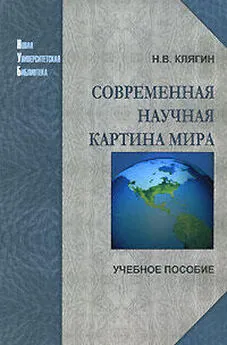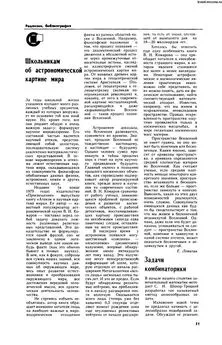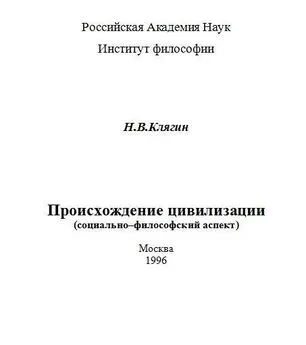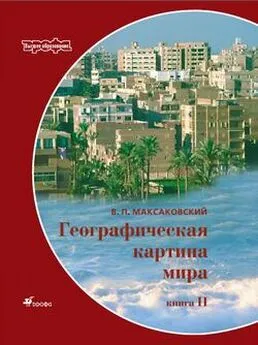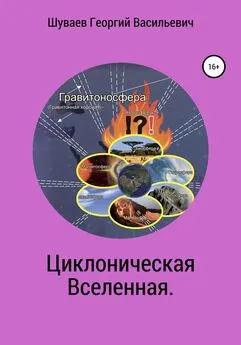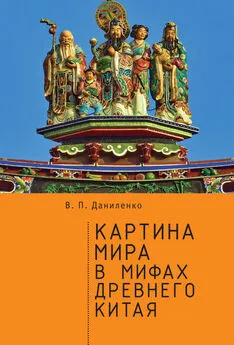Николай Клягин - Современная научная картина мира
- Название:Современная научная картина мира
- Автор:
- Жанр:
- Издательство:Литагент «Логос»439b7c39-76ee-102c-8f2e-edc40df1930e
- Год:2007
- Город:Москва
- ISBN:5-98704-134-1
- Рейтинг:
- Избранное:Добавить в избранное
-
Отзывы:
-
Ваша оценка:
Николай Клягин - Современная научная картина мира краткое содержание
Рассматривается современная научная картина мира, охватывается широчайший спектр данных космогонии, биогенеза, антропогенеза, социогенеза и др. Эти данные настолько разнородны, что подпадают под общий знаменатель только на уровне универсального причинно-следственного закона. Для понимания его происхождения необходимо объяснить, как возникли законы сохранения и неубывания энтропии. Чтобы протянуть нить причинности от физического и астрономического мира к человеческому обществу, нужно осмыслить пути и результаты биоэволюции. Все это дает нам возможность понять, где находится центр Вселенной, как и почему возникли и угасли динозавры, отчего человек единственный на планете обладает наукой и искусством.
Для студентов высших учебных заведений, изучающих курс «Концепция современного естествознания». Может использоваться аспирантами при подготовке к экзамену по кандидатскому минимуму в области истории и философии науки.
Современная научная картина мира - читать онлайн бесплатно полную версию (весь текст целиком)
Интервал:
Закладка:
518. Lucas S. The rise of the dinosaur dynasty // New scientist. 1990. V. 128, № 1737. P. 44–46.
519. Lumley H. de. Cultural Evolution in France in its Paleoecological Setting During the Middle Pleistocene // After the Australopithecines. Stratigraphy, Ecology, and Culture Change in the Middle Pleistocene. The Hague, P. : Mouton Publishers, 1975. P. 745–808.
520. Lumley H. de. Cadre chronologique absolu, paléomagnétisme, chronologie paléontologique et botanique, esquisse paléoclimatologique, séquences culturelles // La préhistoire française. Les civilisations paléolithiques et mésolithiques de la France. Publié à l’occasion du IX eCongrès de l’U.I.S.P.P., Nice, 1976. Paris: Éditions du Centre national de la recherche scientifique, 1976. T. I, part 1. P. 5–23.
521. Lumley H. de. Les civilisations du Paléolithique inférieur en Provence // La préhistoire française. Les civilisations paléolithiques et mésolithiques de la France. Publié à l’occasion du IX eCongrès de l’U.I.S.P.P., Nice, 1976. Paris: Éditions du Centre national de la recherche scientifique, 1976. T. I, part 2. P. 819–851.
522. Lynch M., Conery J. S. The Evolutionary Fate and Consequences of Duplicate Genes // Science. 2000. V. 290, № 5494. P. 1151–1155.
523. Lynch M., Conery J. S. The Origins of Genome Complexity // Science. 2003. V. 302, № 5649. P. 1401–1404.
524. Lynden-Bell D., Faber S. M., Burstein D., Davies R. L., Dressler A., Terlevich R. J., Wegner G. Spectroscopy and photometry of elliptical galaxies. V. Galaxy streaming toward the new supergalactic center // The Astrophisical Journal. 1988. V. 326, № 1, part 1. P. 19–49.
525. Maber K. A., Stevenson D. J. Impact frustration of the origin of life // Nature. 1988. V. 331, № 6157. P. 612–614.
526. MacLeod K. G., Huber B. T. Reorganization of deep ocean circulation accompanying a Late Cretaceous extinction event // Nature. 1996. V. 380, № 6573. P. 422–425.
527. Madore B. F., Freedman W. L., Silbermann N., Harding P., Huchra J., Mould J. R., Graham J.A., Ferrarese L., Gibson B.K., Han M., Hoessel J.G, Hughes S.M., Illingworth G D., Phelps R, Sakai S., Stetson P. A Cepheid distance to the Fornax cluster and the local expansion rate of the Universe // Nature. 1998. V. 395, № 6697. P. 47–50.
528. Maddox J. Have the heavy neutrinos gone? // Nature. 1986. V. 323, № 6083. P. 11.
529. Maddox J. Prospects for fifth force fade // Nature. 1987. V. 329, № 6137. P. 283.
530. Maddox J. The search for dark matter (contd) // Nature. 1992. V. 359, № 6393. P. 267.
531. Maddox J. Big Bang not yet dead but in decline // Nature. 1995. V. 377, № 6545. P. 99.
532. Malaney R. A., Fowler W. A. The Transformation of Matter after the Big Bang // American Scientist. 1988. V. 76, № 5. P. 472–477.
533. Mania D. Auf den Spuren des Urmenchen: Die Funde aus der Steinrinne von Bilzingsleben. Berlin: Deutscher Verlag der Wissenschaften, 1990. 283 S.
534. Margolis S. V. Paleoglacial history of Antarctica inferred from analysis of Leg 29 sediments by scanning-electron microscopy // Initial Reports of the Deep Sea Drilling Project. Washington: US Government Printing Office, 1975. V. 29. P. 1039–1048.
535. Marshack A. The roots of civilization. N. Y: McGraw-Hill Book Company, 1972. 413 p.
536. Marshack A. Implications of the Paleolithic Symbolic Evidence for the Origin of Language // American Scientist. 1976. V. 64, № 2. P. 136–145.
537. Marshack A. Some Implications of the Paleolithic Symbolic Evidence for the Origin of Language // Current Anthropology. 1976. V. 17, № 2. P. 274–282.
538. Marshack A. On Paleolithic Ochre and the Early Uses of Color and Symbol // Current Anthropology. 1981. V. 22, № 2. P. 188–191.
539. Marshack A. Non-utilitarian fragment of bone from the middle palaeolithic layer // Excavation in the Bacho Kiro cave (Bulgaria): Final report. Warszawa: Państwowe wydawnictwo naukowe, 1982. P. 117.
540. Marshall J. C. The descent of the larynx? // Nature. 1989. V. 338, № 6218. P. 702–703.
541. Martin B., Harvey P. H. Human bodies of evidence // Nature. 1987. V. 330, № 6150. P. 697–698.
542. Martin H. Comment vivait l’Homme de La Quina à l’époque moustérienne // Préhistoire. Paris: Librairie Ernest Leroux, 1936. T. 5. P. 7–23.
543. Martin R. D. New fossils and primate origins // Nature. 1991. V. 349, № 6304. P. 19–20.
544. Martin R. D. Primate origins: plugging the gups // Nature. 1993. V. 363, № 6426. P. 223–234.
545. Martin W., Gierl A., Saedler H. Molecular evidence for pre-Cretaceous angio-sperm origins // Nature. 1989. V. 339, № 6219. P. 46–48.
546. Martinez V. J. Is the Universe Fractal? // Science. 1999. V. 284, № 5413. P. 445–446.
547. Mather J. A look at the primeval explosion // New scientist. 1986. V. 109, № 1491. P. 48–50.
548. Mathewson D. S., Ford V.L., Buchhorn M. No back-side in fall into the Great Attractor // The Astrophisical Journal. 1992. V. 389, № 1, part 2. Letters. P. 5–8.
549. Matsuzawa T. Use of numbers by a chimpanzee // Nature. 1985. V. 315, № 6014. P. 57–59.
550. Matthews J. Good vibrations from the stars // New scientist. 1990. V. 125, № 1701. P. 46–50.
551. Matthews R. Can gravity take a quantum leap? // New scientist. 1994. V. 143, № 1942. P. 26–32.
552. Matthews R. Nothing like a vacuum // New scientist. 1995. V. 145, № 1966. P. 30–33.
553. Matthews R. K. Relative elevation of Late Pleistocene high sea level stands: Barbados uplift rates and their implications // Quaternary research. 1973. V. 3, № 1. P. 147–153.
554. Maurrasse F. J-M. R., Sen G. Impacts, Tsunamis, and the Haitian Cretaceous-Tertiary Boundary Layer // Science. 1991. V. 252, № 5013. P. 1690–1693.
555. May R. M. How Many Species Are There on Earth? // Science. 1988. V. 241, № 4872. P. 1441–1449.
556. McCollum M. A. The Robust Australopithecine Face: A Morphogenetic Perspective // Science. 1999. V. 284, № 5412. P. 301–305.
557. McCrone J. Fired up // New scientist. 2000. V. 166, № 2239. P. 30–34.
558. McDonald M. Iridium: tracking down the extraterrestrial element in sedimentary clays // New scientist. 1988. V. 121, № 1652. P. 58.
559. McDougall I., Brown F. H., Fleagle J.G. Stratigraphic placement and age of modern humans from Kibish, Ethiopia // Nature. 2005. V. 433, № 7027. P. 733–736.
560. McElwain J. C., Beerling D. J., Woodward F. I. Fossil Plants and Global Warming after Triassic-Jurassic Boundary // Science. 1999. V. 285, № 5432. P. 1386–1390.
561. McHone J. F., Nieman R. A., Lewis C. F., Yates F.M. Stishovite at the Cretaceous-Tertiary Boundary, Raton, New Mexico // Science. 1989. V. 243, № 4895. P. 1182–1184.
562. McKay C. P., Borucki W. J. Organic Synthesis in Experimental Impact Shocks // Science. 1997. V. 276, № 5311. P. 390–392.
563. McKinnon W. B. Killer acid at the K/T boundary // Nature. 1992. V. 357, № 6373. P. 15–16.
564. McNamara K. The great evolutionary handicap // New scientist. 1989. V. 123, № 1682. P. 47–51.
565. Melchor R. N., Valais S. de, Genise J.F. Bird-like fossil foot-prints from the Late Triassic // Nature. 2002. V. 417, № 6892. P. 936–938.
566. Mellars P. A new chronology for the French Mousterian period // Nature. 1986.
V 322, № 6078. P. 410–411.
567. Mellars P. Neanderthals and the modern human colonization of Europe // Nature. 2004. V. 432, № 7016. P. 461–465.
567à. Mellars P. A new radiocarbon revolution and the dispersal of modern humans in Eurasia // Nature. 2006. V. 439, № 7079. P. 931–935.
568. Mercader J., Panger M., Boesch C. Excavation of a Chimpanzee Stone Tool Site in the African Rainforest // Science. 2002. V. 296, № 5572. P. 1452–1455.
569. Mercier N., Valladas H. , Joron J.-L., Reyss J.-L., Lévéque F., Vandermeersch B. Thermoluminescence dating of the late Neanderthal remains from Saint-Césaire // Nature. 1991. V. 351, № 6329. P. 737–739.
570. Miller G H., Magee J. W., Johnson B. J., Fogel M. L., Spooner N. A., McCulloch M. T., Ayliffe L. K. Pleistocene Extinction of Genyornis newtoni: Human Impact on Australian Megafauna // Science. 1999. V. 283, № 5399. P. 205–208.
571. Miller S. L., Bada J. L. Submarine hot springs and the origin of life // Nature. 1988. V. 334, № 6183. P. 609–611.
572. Mirazón Lahr M., Foley R. Human evolution writ small // Nature. 2004. V. 431, № 7012. P. 1043–1044.
573. Mithen S. J. To hunt or to paint: animals and art in the Upper Palaeolithic // Man. 1988. V. 23, № 4. P. 671–695.
574. Mojzsis S. J., Arrhenius G., McKeegan K. D., Harrison T. M., Nutman A. P., Friend C. R. L. Evidence for life on Earth before 3,800 million years ago // Nature. 1996. V 384, № 6601. P. 55–59.
575. Mojzsis S. J., Harrison T. M., Pidgeon R. T. Oxygen-isotope evidence from ancient zircons for liquid water at the Earth’s surface 4,300 Myr ago // Nature. 2001. V. 409, № 6817. P. 178–181.
576. Montagu M. F. A. Wolf children // The Origin & Evolution of Man: Readings in physical anthropology. N. Y: T. Y Crowell C°, Inc., 1973. P. 248–253.
577. Montagu M. F. A. The meaning of neonatal and infant immaturity in man // The Origin & Evolution of Man: Readings in physical anthropology. N. Y: T. Y Crowell C°, Inc., 1973. P. 257–260.
578. Mooers A. 0., Redfield R J. Digging up the roots of life // Nature. 1996. V. 379, № 6566. P. 587–588.
579. Mook W. G. Radiocarbon dating // Excavation in the Bacho Kiro cave (Bulgaria): Final report. Warszawa: Panstwowe wydawnìctwo naukowe, 1982. P. 168.
580. Moorbath S., Taylor P. N., Orpen J. L., Treloar P., Wilson J. F. First direct radiometric dating of Archaean stromatolitic limestone // Nature. 1987. V. 326, № 6116. P. 865–867.
581. Moore B. Evidence against dissipationless from observations of galaxy halos // Nature. 1994. V. 370, № 6491. P. 629–631.
582. Morey D. F. The Early Evolution of the Domestic Dog // American Scientist. 1994. V. 82, № 4. P. 336–347.
583. Morgan E. Lucy’s child // New scientist. 1986/1987. V. 112, № 1540/1541. P. 13–15.
584. Morris D. The naked ape. L.: Gorgi books, 1975. 219 p.
584a. Morwood M. J., Brown P., Jatmiko, Sutikna T., Saptomo E. W., Westaway K. E., Due R. A., Roberts R. G., Maeda T., Wasisto S., Djubiantono T. Further evidence for small-bodied hominins from the Late Pleistocene of Flores, Indonesia // Nature/ 2005. V. 437, № 7061. P. 1012–1017.
585. Morwood M. J., Soejono R. P., Roberts R. G., Sutikna T., Turney C. S. M., Westaway K. E., Rink W. J., Zhao J.-x., Bergh G. D. van den, Due R. A., Hobbs D. R., Moore M. W., Bird M. I., Fifield L. K. Archaeology and age of a new hominin from Flores in eastern Indonesia // Nature. 2004. V. 431, № 7012. P. 1087–1091.
586. Moskowitz B. The search for dark matter in the laboratory // New scientist. 1989. V. 122, № 1660. P. 39–42.
587. Movius, Jr. H. L. Early man and pleistocene stratigraphy in Southern and Eastern Asia. Cambridge, Mass., USA: Peabody museum, 1944. IX, 125 p.
588. Mungall J. E., Ames D. E., Hanley J. J. Geochemical evidence from the Sudbury structure for crustal redistribution by large bolide impacts // Nature. 2004. V. 429, № 6991. P. 546–548.
Читать дальшеИнтервал:
Закладка:
